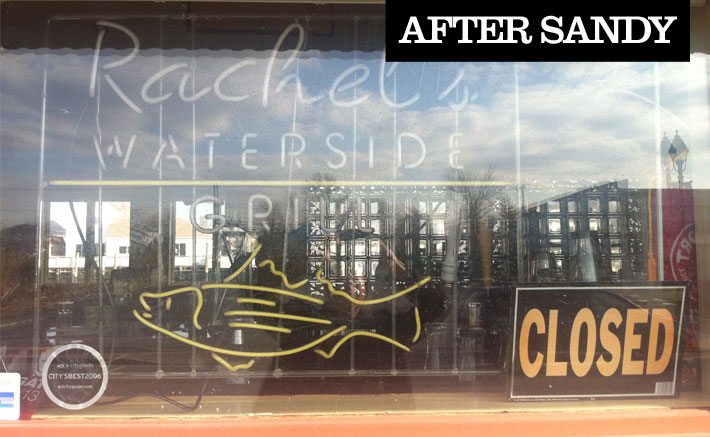
 Scott Bochner stands on the plush white carpet of his living room floor on West Bay Drive in Long Beach and scans the breathtaking view with his binoculars.
Scott Bochner stands on the plush white carpet of his living room floor on West Bay Drive in Long Beach and scans the breathtaking view with his binoculars.
Outside his window laps the blue waters of Reynolds Channel, a several mile-long strait connecting the Atlantic Ocean to Broad Channel and Long Island’s network of Western Bays. A steady wind blows from the west. Boats docked along his street rock back and forth in rhythm. Across the channel are vast marshlands. To the west are some of the most gorgeous sunsets you’ll ever see tucking slowly behind the silhouette of Manhattan.
Yet along the opposite bank, almost directly across from his home, juts a peculiar, if not unassuming, white-topped, orange-bricked structure. It’s square-shaped, several feet in diameter and appears surrounded by tiny specks of white dots that bob up and down with the licking water. Miniature black figures line the top. It’s currently the subject of Bochner’s gaze.
“It happens around 3 o’clock,” he says to this reporter, his neighbor Jim Hangley, who lives two doors down, and Claudia Borecky, president of the North Merrick Community Association, who also stopped by. “You’ll start seeing a small plume of brown. And then all of a sudden it just, erupts. If you look at the video you’ll see there’s just a big line. The birds are flying—it’s fierce, fierce, because they know what’s coming up and they’re eating it.”
The video Bochner’s referring to is any one of five he’s filmed from his rooftop deck and posted on YouTube. They span incidents occurring Sept. 4 to as recent as Dec. 14. Each document mammoth thick brown-gray plumes emanating from the structure, staining the waterway across its width, attracting swarms of scavengers and creeping east down the length of the channel into the horizon toward the popular fishing spot Magnolia Pier. Bochner says he’s got plenty more not posted yet, and “hundreds” of photographs.
This reporter takes a closer look with the field glasses.
The white specks become dozens upon dozens of large seagulls floating alongside its perimeter, with statuesque darker birds perched atop.
Intermittently since July—sometimes almost on a daily basis, Bochner tells the Press—he’s witnessed the discolored stew and its subsequent avian feeding frenzy from his roughly $1 million home (which he pays roughly $15,000 annually in taxes to live in) overlooking the otherworldly waters. A lifelong Long Beacher, Bochner grew up in these waters and still surfs, swims, boats and fishes here—along with his two children.

Dinner Time: A hungry seagull and friends await their next meal at Nassau County's Bay Park Sewage Treatment Plant outflow pipe (back center) in Reynolds Channel. (Christopher Twarowski / Long Island Press)
The spewing square is the outflow pipe of Nassau County’s Bay Park Sewage Treatment Plant, also visible from Bochner’s living room, which excretes an average daily flow of about 55 million gallons of effluent—treated wastewater, fecal matter and whatever else residents and businesses flush down their toilets or dump down their drains.
But it’s not supposed to come out brown. And it’s not herring the birds are dining on. It’s biosolids, or, as sewage workers know it, sludge.
Bochner and a growing number of residents, environmentalists, civil leaders—as well as a handful of politicians—are mad as hell, not just about the “discharge of excess treated solids” the county admits has been belching into the waters where countless people come from all around to swim, boat and fish in. They’re mad because local, state and federal government, health and regulatory officials have still not posted warnings, issued notifications, made an announcement, or officially informed the public in any way about the potential dangers posed from th
 e expulsions.
e expulsions.
The Bay Park Sewage Plant and its sister facility, the troubled Cedar Creek Water Pollution Control Plant in Wantagh, have been the subject of an ongoing Press investigative series that began more than five years ago [“Toxic Offender,” Sept. 22, 2005, “Toxic Time Bomb,” April 29, 2010 and “Death Threats, Demands & Inquiries,” July 29, 2010].
Much has happened since the recent installments—including investigations by local, state and federal regulators including the Nassau County District Attorney’s Office, New York State Department of Environmental Conservation (DEC) and the U.S. Environmental Protection Agency. Perhaps most importantly, vast and significant improvements to both plants by the administration of Nassau County Executive Ed Mangano, who inherited the current conditions of the two facilities from former Nassau County Executive Tom Suozzi.
Yet much, much more work remains to be done to ensure the health and safety of both plants’ workers, the public the plants serve and the environment they empty into—as the vile brown plumes snaking through Reynolds Channel are testament. This reporter learned firsthand the immediate improvements still yet to be made in the plants’ emergency medical equipment and protocol, suffering a head wound when no hard hats were given to visitors during a recent tour of Cedar Creek. The injury required several stitches, two trips to the emergency room, a Tetanus shot and regimen of antibiotics to combat what workers describe as “spontaneous” infections within its walls. Emergency medical stations are stocked with incomplete and outdated supplies. They don’t even have a 71-cent bottle of hydrogen peroxide to clean out wounds. Nor do they have a safety officer—which legislators have called for since 2005—who would actually know how to handle such a situation instead of continuing to parade the injured around a sewage plant with an open head wound.
plants’ emergency medical equipment and protocol, suffering a head wound when no hard hats were given to visitors during a recent tour of Cedar Creek. The injury required several stitches, two trips to the emergency room, a Tetanus shot and regimen of antibiotics to combat what workers describe as “spontaneous” infections within its walls. Emergency medical stations are stocked with incomplete and outdated supplies. They don’t even have a 71-cent bottle of hydrogen peroxide to clean out wounds. Nor do they have a safety officer—which legislators have called for since 2005—who would actually know how to handle such a situation instead of continuing to parade the injured around a sewage plant with an open head wound.
Point Lookout residents have been gassed with another byproduct of Bay Park’s expulsions (irregular or not): baseball stadiums’ worth of mammoth heaps of toxic seaweed, spawned from the plant’s daily millions of gallons of undissolved nutrients. The dense bright green and desert brown mounds strangle marine life and choke surrounding communities by releasing hydrogen sulfide, which causes chemical changes in the human brain and nervous system failure depending upon exposure levels, according to the New York State Department of Health (DOH).
While much of the attention—especially since April—has been on Cedar Creek, Bochner’s YouTube videos and an online petition he started to “Stop The Dumping In Reynolds Channel” (with more than 1,100 signatures, many who complain of ear infections and other health problems from swimming or surfing in the waterway) have opened the toxic Pandora’s Box that is Bay Park. And with that added sunlight came revelations.

Sounding The Alarm: Lifelong Long Beach resident Scott Bochner, who has been documenting illegal waste and sludge discharges from Nassau's Bay Park Sewage Treatment Plant from his living room and posting the footage on YouTube.
Internal reports and correspondences between Nassau and the DEC reviewed by the Press, including illegal discharge reports which document violations of Nassau’s State Pollutant Discharge Elimination System (SPDES) permit, as well as a Dec. 13 tour of the embattled plant, dozens of interviews and incidents witnessed firsthand, reveal a long track record of gross abject neglect and/or intentional destruction at the more than 50-year-old facility.
And perhaps the most shocking revelation of all, the Press has discovered local, state and federal regulators, along with county sewage supervisors and some employees, all knew about Bay Park’s woes and illegal discharges, for years, and have never alerted the public or closed the popular fishing waters.
“Because it’s county run, it doesn’t give them the permission, or the right, to dump anything illegal into the channel, or into any waterway,” stresses Bochner. “The [U.S.] Clean Water Act applies to this.”
“Anytime there was something [illegally discharged] they should have said, ‘An accident happened, it was something that we couldn’t avoid and there was a spill. Be careful in the waters for the next two weeks.’”
Ditto for warnings to duck hunters, who consume birds that also feed on the sludge.
He and his neighbor, Hangley, have invited a host of elected and public officials to come to his home with their children to feast on some of Reynolds Channel’s sludge-marinated catch for themselves since the government doesn’t feel it’s necessary to post warnings about the illegal excretions. So far, none have taken them up on the offer.
Messages for comment left at the home and on the cell phone of Nassau County’s Superintendent of Sewage Plants, Unit Head of Environmental Operations, Richard Cotugno, who has been at the helm of both Cedar Creek and Bay Park since the 1990s, were not returned. He has refused to speak with the Press regarding any previous story.






